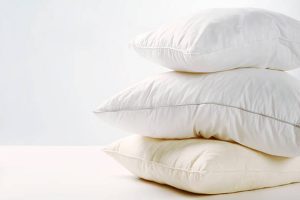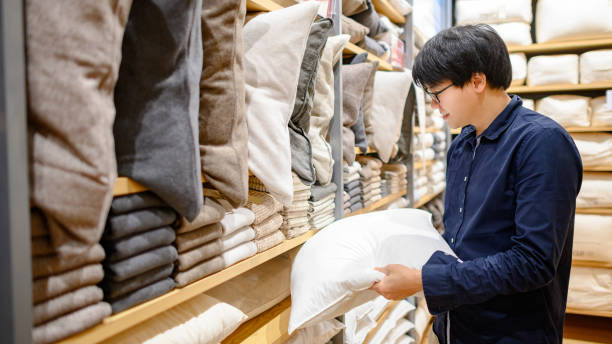Table of Contents
ToggleChoosing the right pillow may seem like a trivial matter, but it can significantly impact the quality of your sleep and overall health.
At some point in your life, you’ve probably had trouble sleeping because your pillow was too flat, too thick, too firm, or too soft. If you’re in the market for a new pillow, you’re in luck! In this comprehensive guide, we’ll help you choose the perfect pillow that suits your needs, preferences, and sleeping position.
Different Sleeping Positions

There are three main sleeping positions: back, stomach, and side. Each position has its advantages and disadvantages. The back sleeping position is considered the best position for overall spinal alignment and reducing the risk of developing wrinkles. It can lead to snoring and sleep apnea. The stomach sleeping position may reduce snoring, but it can cause neck and back pain. The side sleeping position is the most common and is known to reduce snoring and alleviate sleep apnea.
Pillow Requirements for Each Position
The pillow requirements for each sleeping position are different. For back sleepers, a thinner pillow is recommended to keep the head in a neutral position. A pillow that is too thick can cause the neck to arch forward, leading to pain and discomfort. For stomach sleepers, a very thin pillow or no pillow at all is recommended to avoid putting too much strain on the neck. Side sleepers require a firmer, thicker pillow to support the head and keep the spine aligned.
How to Determine Your Sleeping Position
Determining your sleeping position is an important aspect of achieving a restful night’s sleep. Start by evaluating your comfort level in different positions, such as sleeping on your back, stomach, or side. Pay attention to how your body feels in each position, especially your neck and spine alignment. Your preferred sleeping position should provide proper support and alignment for your body. Consider investing in a supportive pillow and mattress to enhance your comfort level. Experiment with different sleeping positions until you find the one that works best for you, ensuring a comfortable and rejuvenating sleep each night.
Pillow Types: A Comprehensive Guide

When it comes to getting a good night’s sleep, having the right pillow is just as important as having a comfortable mattress. With so many different pillow types on the market, it can be difficult to know which one is right for you. Here is a comprehensive guide to the most popular pillow types:
Feather Pillows
Feather pillows are a classic choice, filled with feathers and often mixed with down. They are soft and comfortable, but they may not provide enough support for some sleepers.
Down Pillows
Down pillows are similar to feather pillows, but they are filled only with the soft down feathers found on the underside of geese and ducks. They are very lightweight and provide excellent insulation, making them perfect for colder climates.
Memory Foam Pillows
Memory foam pillows are designed to contour your head and neck, providing support and pressure relief. They are often recommended for people with neck or back pain, as they can help alleviate pressure points.
Latex Pillows
Latex pillows are made from natural or synthetic latex, which is a resilient and supportive material. They are often recommended for people who need more support than a feather or down pillow can provide.
Polyester Pillows
Polyester pillows are a more affordable option, often used in hotels and guest rooms. They are lightweight and easy to clean, but they may not last as long as other pillow types.
Buckwheat Pillows
Buckwheat pillows are filled with buckwheat hulls, which conform to the shape of your head and neck. They are a popular choice for people who prefer a firmer pillow and are often recommended for people with allergies.
Pillow Firmness: Choosing the Right Level of Support for Your Needs
Pillow firmness is a crucial aspect of getting a good night’s sleep. The level of firmness determines the amount of support the pillow provides for your neck and head.
Soft Pillows
Soft pillows are ideal for those who sleep on their stomachs or those who prefer a more plush feel. They offer minimal support but provide a comfortable, sink-in feeling. It’s important to note that a pillow that’s too soft can cause your head to sink too far into the pillow, leading to neck strain.
Medium Pillows
Medium pillows are the most common choice as they offer a balance of support and comfort. They are suitable for back sleepers and those who switch between sleeping positions throughout the night. It’s important to choose a pillow that’s not too soft or too firm to avoid discomfort and restless sleep.
Firm Pillows
Firm pillows are an excellent option for side sleepers as they offer greater support for the neck and head. They keep the head and neck aligned with the spine, preventing pain and discomfort. Choose a pillow that’s not too firm to avoid pressure points and discomfort.
Extra-Firm Pillows
Extra-firm pillows are ideal for people who prefer a very high level of support. They are particularly beneficial for those with chronic neck or back pain as they provide maximum support. Note that they may not be suitable for everyone and can cause discomfort if not properly matched to your body type and sleeping position.
The Importance of Pillow Size for a Good Night’s Sleep
When it comes to getting a good night’s sleep, choosing the right pillow size is essential. A pillow that is too small or too large can cause discomfort, leading to poor sleep quality and potential neck and back pain. In this article, we will explore the different pillow sizes available and which ones are best suited for various sleeping positions and bed sizes.
Standard Pillows: The Most Common Size
Standard pillows are the most common size and measure around 20 inches by 26 inches. They are a great choice for twin or full-sized beds and for people who sleep on their backs or stomachs. Standard pillows are also an affordable option for those on a budget.
Queen Pillows: Slightly Larger for More Comfort
Queen pillows are slightly larger than standard pillows, measuring around 20 inches by 30 inches. They are an excellent choice for queen-sized beds or for individuals who prefer a larger pillow. Queen pillows can provide more comfort and support for those who sleep on their sides.
King Pillows: The Largest Standard Pillow Size
For those with a king-sized bed, king pillows are the way to go. They measure around 20 inches by 36 inches, making them the largest standard pillow size. King pillows are perfect for those who like to prop themselves up while reading or watching TV in bed, as well as for people who like to hug their pillow while they sleep.
Euro Pillows: Square-Shaped and Decorative
Euro pillows are a different type of pillow altogether, as they are square-shaped and measure around 26 inches by 26 inches. They are typically used as decorative pillows or as a backrest while sitting up in bed. Euro pillows can be a great addition to a bedding set, as they can add a pop of color or texture to the overall look of a room.
Choosing a Pillow Loft
Pillow loft is a term used to describe the height or thickness of a pillow. There are three main types of pillow lofts: low, medium, and high. Each type of loft has its own unique characteristics and benefits, making it important to choose the right one based on your sleeping preferences.
- Low loft pillows are typically the thinnest of the three types and are best suited for stomach sleepers. These pillows are designed to keep your head and neck in a neutral position to prevent strain and discomfort. They are also great for people with smaller frames, as they won’t elevate the head too much and cause discomfort.
- Medium loft pillows are a great all-around option that can work for most sleeping positions. These pillows provide a good balance of support and comfort, making them a popular choice for people who switch between sleeping on their back, side, or stomach. They also work well for people with average-sized frames.
- High loft pillows are the thickest of the three and are designed for people who prefer to sleep on their side. These pillows offer the most support and can help keep the spine aligned while sleeping. They are also great for people with larger frames, as they provide more elevation and support than low or medium-loft pillows.
When choosing a pillow loft, it’s important to consider your sleeping position, body size, and personal preferences. It’s also a good idea to try out different types of pillows before making a purchase to find the one that provides the most comfort and support for your needs. With the right pillow loft, you can improve the quality of your sleep and wake up feeling refreshed and ready to take on the day.
Pillow Shape: Choosing the Right Pillow for You
Pillows come in different shapes and sizes, each designed to serve a specific purpose. Traditional pillows are rectangular or square-shaped and are filled with materials like feathers, down, or synthetic fibers. They are the most commonly used pillows and are suitable for most sleep positions.
Traditional Pillows
Traditional pillows are the most common type of pillow and come in rectangular or square shapes. They are filled with materials like feathers, down, or synthetic fibers. They are suitable for most sleep positions and are available in different firmness levels.
Contour Pillows
Contour pillows have a curved shape that is designed to support the neck and head. They are made of memory foam or latex, which conforms to the shape of the head and neck, providing a comfortable and supportive sleeping surface. Contour pillows are suitable for people who suffer from neck pain, snoring, or sleep apnea.
Wedge Pillows
Designers create wedge pillows as triangular-shaped pillows that elevate the upper body to alleviate symptoms of acid reflux, snoring, and sleep apnea. People can also use them to support themselves while reading, watching TV, or working on a laptop while in bed.
Body Pillows
Body pillows are long, cylindrical-shaped pillows that provide support for the entire body. They are typically used by side sleepers who need extra support for their hips, knees, and shoulders. Body pillows can also be used during pregnancy to support the belly and reduce discomfort.
Pillow Cover Materials
They are an essential accessory that not only adds a touch of style to your bedding but also protects your pillow from dust, dirt, and spills. Covers come in a variety of materials, each with its own unique benefits and drawbacks.
Cotton Pillow Covers
These pillow covers are a popular choice due to their softness, durability, and breathability. Cotton is a natural fabric that allows air to circulate freely, preventing sweat and heat buildup while you sleep. Cotton covers are easy to wash and maintain, making them an ideal choice for busy households.
Bamboo Pillow Covers
These pillow covers are another great option, particularly for those who suffer from allergies or have sensitive skin. Bamboo is hypoallergenic and naturally antibacterial, making it an excellent choice for people who want to keep their bedding clean and fresh. Bamboo covers are also very soft and silky, providing a comfortable sleeping surface.
Silk Pillow Covers
These pillow covers are a luxurious choice that adds a touch of elegance to your bedding. Silk is a very soft and smooth fabric that feels great against your skin, and it is also naturally hypoallergenic. Silk pillow covers are more delicate and require special care when washing and handling.
Synthetic Pillow Covers
Synthetic pillow covers are made from materials like polyester, microfiber, or nylon. These covers are typically less expensive than natural fiber covers, and they are also easy to care for and maintain. Synthetic covers are often less breathable than natural covers, which can lead to sweat and heat buildup while you sleep.
Allergies and Sensitivities: Understanding the Difference

Allergies occur when the immune system reacts to a harmless substance as if it were a threat. This can cause symptoms such as hives, itching, and difficulty breathing. Sensitivities, on the other hand, refer to adverse reactions to specific substances that do not involve the immune system. These reactions can cause symptoms such as nausea, headaches, and skin irritation. Understanding the difference between allergies and sensitivities is important in finding the right treatment.
Hypoallergenic Pillows: A Solution for Allergy Sufferers
Hypoallergenic pillows are a popular solution for people who suffer from allergies. These pillows are made from materials that are less likely to cause an allergic reaction, such as synthetic fibers or down alternatives. They are also often treated with antimicrobial agents to prevent the growth of bacteria and other allergens. In this section, we will discuss the benefits of hypoallergenic pillows, how to choose the right one, and tips for maintaining them.
Anti-Dust Mite Pillows: Keeping Allergens at Bay
Dust mites are a common allergen found in many homes. These microscopic creatures feed on dead skin cells and thrive in warm, humid environments. Anti-dust mite pillows are designed to repel these allergens, making them a popular choice for people who suffer from allergies. These pillows are typically made from tightly woven materials that prevent dust mites from penetrating the fabric. In this section, we will explore the benefits of anti-dust mite pillows, how they work, and how to choose the right one.
Organic Pillows: A Natural Solution for Sensitivity Sufferers
For people who are sensitive to chemicals and other irritants, organic pillows may be a good solution. These pillows are made from natural materials, such as organic cotton or wool, that are free from chemicals and other irritants. They are also often treated with natural materials such as essential oils to repel allergens. In this section, we will discuss the benefits of organic pillows, how to choose the right one, and how to care for them to ensure they last.
Temperature Regulation

Temperature regulation is a critical aspect of maintaining a comfortable and healthy environment, both indoors and outdoors. Our bodies are designed to maintain a core temperature of around 98.6 degrees Fahrenheit (37 degrees Celsius), and any deviation from this temperature can cause discomfort or even health problems. There are various ways to regulate body temperature, and two popular options are cooling pillows and heating pillows.
Cooling Pillows
Cooling pillows are designed to dissipate heat and provide a cool surface for the head and neck, helping to regulate body temperature during sleep. These pillows often contain materials such as gel or memory foam, which absorb and dissipate heat, keeping the pillow cool to the touch. They are especially useful during hot summer nights or for people who tend to overheat during sleep.
Heating Pillows
On the other hand, heating pillows provide warmth and comfort during cold weather or when recovering from an injury. Manufacturers design these pillows with materials such as rice or buckwheat, which you can heat in the microwave or oven and then place on the affected area.
The heat helps to increase blood flow, promote relaxation, and reduce pain and inflammation.
Durability: The Lifespan of Different Pillow Types and How to Maintain Them

When it comes to pillow durability, the material used is a significant factor to consider. Synthetic pillows made from materials like polyester and memory foam tend to last longer than natural pillows filled with feathers or down. This is because synthetic materials are more resistant to wear and tear and hold their shape better over time. On the other hand, natural pillows tend to lose their shape and become less supportive over time.
Maintaining Pillow Durability: Proper Cleaning and Storage
To ensure that your pillow lasts as long as possible, proper maintenance is necessary. This involves following the care instructions provided by the manufacturer and cleaning and storing your pillow correctly.
Cleaning Your Pillow
Regular cleaning can help remove dirt, oils, and sweat that can cause your pillow to break down over time. Some pillow types, such as those filled with down or feathers, may require special cleaning methods to avoid damaging the filling. Always check the care label and follow the instructions provided.
Storing Your Pillow
Storing your pillow correctly can also help maintain its durability. When not in use, pillows should be stored in a cool, dry place to prevent moisture from building up, which can cause mold or mildew to form. Storing your pillow in a breathable pillowcase or cover can help protect it from dust and other particles that can cause it to wear out prematurely.
The Importance of Personal Preference When Choosing a Pillow

When it comes to pillows, personal preference is key. Everyone has their own idea of what makes the perfect pillow, and several factors come into play. Softness preference is perhaps one of the most important considerations. Some people prefer a pillow that is soft and fluffy, while others like a firmer pillow that provides more support.
Softness Preference: Finding the Right Level of Comfort
When it comes to pillows, softness preference is perhaps one of the most important considerations. Some people prefer a pillow that is soft and fluffy, while others like a firmer pillow that provides more support. The level of softness is often determined by the filling of the pillow.
Thickness Preference: Finding the Right Height for Your Sleeping Position
Another important factor is thickness preference. Some people prefer a thin pillow, while others like a pillow that is thick and plush. This is often determined by the sleeping position of the individual. For example, someone who sleeps on their stomach may prefer a thinner pillow, while a side sleeper may want a thicker pillow to help align their spine.
Shape Preference: Finding the Right Contour for Neck Support
Shape preference is also important when it comes to pillows. Some people prefer a standard rectangular shape, while others prefer a contoured shape that is designed to cradle the head and neck. Contoured pillows are often recommended for people who suffer from neck pain or stiffness, as they can help to alleviate pressure points.
Material Preference: Finding the Right Filling for Your Needs
Finally, material preference is another key consideration when choosing a pillow. There are many different materials to choose from, including down, synthetic fibers, memory foam, and latex. Each material has its own unique benefits and drawbacks.
Budget
Budget-friendly pillow options and high-end pillow options are both great choices when it comes to purchasing a pillow that meets your individual needs. If you’re on a budget, there are plenty of affordable pillow options available on the market that can provide you with a comfortable and supportive night’s sleep. These pillows are typically made from less expensive materials, such as polyester or memory foam, and may have simpler designs.
Budget-friendly pillow options:
If you’re on a budget, there are plenty of affordable pillow options available on the market that can provide you with a comfortable and supportive night’s sleep. These pillows are typically made from less expensive materials, such as polyester or memory foam, and may have simpler designs. That doesn’t mean that they can’t offer a high level of comfort and support.
When looking for a budget-friendly pillow, consider options like:
- Polyester-filled pillows: These are typically the most affordable type of pillow and can still provide good support and comfort. Look for ones with a high thread count for added softness.
- Memory foam pillows: While memory foam pillows can be on the pricier side, there are budget-friendly options available that can still provide excellent support and pressure relief.
- Down alternative pillows: These pillows are made from synthetic materials that mimic the feel of down feathers but at a much lower price point.
High-end pillow options:
If you’re willing to spend a bit more money, there are high-end pillow options available that can provide you with the ultimate sleeping experience.
Luxurious materials like down or silk often make these pillows, and they may feature more intricate designs such as multiple chambers or adjustable fill.
When looking for a high-end pillow, consider options like:
- Down pillows: These pillows are filled with soft, fluffy down feathers from geese or ducks and can provide unparalleled comfort and support. Look for pillows with a high fill power for the best quality.
- Silk pillows: Silk pillows are naturally hypoallergenic and can help regulate your body temperature while you sleep, making them a great option for hot sleepers.
- Adjustable fill pillows: These pillows allow you to add or remove filling to adjust the loft and firmness to your liking, providing a truly personalized sleeping experience.
Ultimately, the pillow you choose will depend on your individual preferences and budget. Whether you opt for a budget-friendly or high-end option, make sure to do your research and read reviews before making a purchase to ensure that you’re getting a quality product that meets your needs.
Testing the Pillow: In-Store and Online Options
Before buying a pillow, it’s essential to test it out to ensure it’s comfortable and supportive. Here are some ways to test a pillow:
In-store testing
When it comes to choosing the right pillow, in-store testing can be a helpful option for many individuals. This method involves physically visiting a store and trying out different pillows to determine which one feels most comfortable. In-store testing allows individuals to touch, feel, and even smell the pillow to determine if it’s the right fit. In-store testing provides the opportunity to speak with a sales associate and ask any questions about the pillow’s materials, firmness, and size. This method is beneficial for those who prefer a hands-on approach and want to make an informed decision.
Online ordering
Alternatively, online ordering is a convenient option for those who prefer not to visit a physical store. Many online retailers offer a trial period, allowing individuals to sleep on the pillow for a certain amount of time before deciding to keep it. This method is great for those with busy schedules or limited access to physical stores. It can be challenging to determine the pillow’s true feel and quality without physically touching it. It’s important to check the return policy before making a purchase to ensure a hassle-free return if the pillow doesn’t meet expectations.
Making the decision
Ultimately, whether to test a pillow in-store or order online depends on individual preferences and circumstances. In-store testing provides a hands-on approach and the ability to ask questions, while online ordering offers convenience and a trial period. Regardless of the method chosen, testing the pillow is crucial to ensure a good night’s sleep and avoid discomfort or pain. By weighing the pros and cons of each option, individuals can make an informed decision that best fits their needs.
Caring for Your Pillow: Washing, Drying, and Storage Instructions

Caring for your pillow is essential to ensure that you get the most out of your investment and maintain a comfortable and hygienic sleeping environment. One of the most important aspects of pillow care is washing it regularly. Depending on the type of pillow you have, you may need to wash it every few weeks or every few months. Check the care label or manufacturer’s instructions to determine the appropriate washing frequency.
Washing Instructions
Caring for your pillow is essential to ensure that you get the most out of your investment and maintain a comfortable and hygienic sleeping environment. One of the most important aspects of pillow care is washing it regularly. Depending on the type of pillow you have, you may need to wash it every few weeks or every few months. Check the care label or manufacturer’s instructions to determine the appropriate washing frequency.
When it’s time to wash your pillow, use mild detergent and warm water. Be sure to remove any pillowcases or covers before washing.
Drying Instructions
After washing your pillow, it’s important to dry it thoroughly to prevent mold or mildew growth. Place your pillow in the dryer with a few clean, dry towels to help absorb moisture. Use a low heat setting and check on the pillow periodically to ensure it’s not overheating. If you prefer to air dry your pillow, place it in a well-ventilated area and fluff it occasionally to help it dry evenly. If you have a foam pillow, avoid using hot water or high heat in the dryer, as this can damage the foam. Instead, air-dry your foam pillow by laying it flat on a towel or hanging it up to dry.
Storage Instructions
When it comes to storing your pillow, it’s best to keep it in a cool, dry place. Avoid storing your pillow in a damp or humid environment, as this can promote mold growth. Keep your pillow away from direct sunlight, as this can cause discoloration and damage to the filling. Consider using a breathable pillow cover or bag to help protect your pillow from dust and dirt while in storage.
Replacing Your Pillow:

Replacing your pillow is an important task that is often overlooked. A good pillow can greatly enhance your sleep quality and provide comfort and support for your neck and head. Over time, pillows can lose their shape and become uncomfortable, leading to poor sleep quality and even neck pain. It is recommended that you replace your pillow every 1 to 2 years, depending on the quality of the pillow and how much it is used. If you notice that your pillow is no longer providing the support and comfort you need, it is time to replace it.
When to replace your pillow:
Replacing your pillow becomes necessary when certain signs emerge. If your pillow lacks comfort and shape, it indicates the need for a replacement. Waking up with neck pain or headaches suggests insufficient support from your pillow. To prevent the accumulation of dust mites and allergens, it is advisable to replace your pillow annually if you have allergies.
Disposing of your pillow:
When it comes time to dispose of your pillow, it is important to do so properly. If your pillow is still in good condition, consider donating it to a local homeless shelter or animal shelter. Some recycling centers accept old pillows and use the materials to make new products such as carpet padding or insulation. If recycling is not an option, you can also dispose of your pillow in the garbage.
Make sure to remove any stuffing and cut up the fabric cover to prevent animals from getting trapped in it.
By replacing your pillow every 1 to 2 years, you can ensure that you are getting the support and comfort you need for a good night’s sleep. Properly disposing of your old pillow can help reduce waste and benefit the environment.
The Pillow Maintenance Checklist: Tips for Extending the Life of Your Pillow

Pillow maintenance is an essential aspect of ensuring a good night’s sleep and extending the life of your pillow. There are several steps that you can take to maintain your pillow properly, including regular cleaning, fluffing, cover replacement, and inspection.
Regular Cleaning: Keep Your Pillow Fresh and Hygienic
One of the most crucial steps in pillow maintenance is regular cleaning. This step helps to remove dirt, dust, and allergens from your pillow, keeping it fresh and hygienic. In this section, we’ll discuss the best ways to clean your pillow and how often you should do it.
Fluffing: Restoring Shape and Comfort
Fluffing your pillow is another essential maintenance task that can help to restore its shape and comfort. In this section, we’ll discuss how to fluff your pillow and why it’s necessary.
Cover Replacement: Protect Your Pillow from Wear and Tear
Replacing your pillow cover is another crucial maintenance step that can help to extend the life of your pillow. In this section, we’ll talk about the importance of pillow covers, how often to replace them, and what types of covers are available.
Inspection: Detecting Potential Issues
Lastly, inspection is another crucial maintenance step that can help to detect any potential issues with your pillow. In this section, we’ll discuss what to look for when inspecting your pillow and when it may be time to replace it or have it professionally cleaned.











